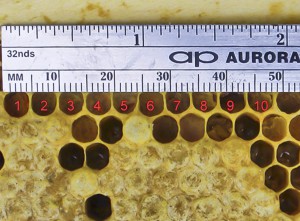interessante Neuigkeiten von resistenten Bienen aus Alabama.
Bericht von unserem Freund Erik Österlund:
http://www.elgon.es/diary/?p=841
Cell size
He uses standard Langstroth equipment with 11 frames (instead of 10) and 31 mm end bars (instead of 35 mm). He also uses small cell 4.9 mm wax foundation. He has a few colonies on 5.3 mm cell size and sees no difference in varroa tolerance or honey production. But the large cell colonies build up slower in spring. This is a bad factor for him and he doesn’t produce any more colonies on 5.3 mm.

Infestation levelDarrel does not do any mite level checks. They are not necessary as he never has seen any big die offs or any bees with virus or wingless bees with DWV. He did check one random colony in 2014 to see how many mites were dropping naturally. Some other beekeepers had asked because they thought his bees were full of mites. This colony dropped 15 mites in 48 days proving them wrong. This makes a downfall of 0.3 mites per day.
Conditions and characteristics for Darrel Jones’ resistant stock
- His area is relatively isolated from nonresistant bees.
- A large population of feral resistant bees are established in the vicinity. This is quite a different situation compared especially to many European areas with bees.
- He began with bee stocks that have excellent resistant traits.
- He is not bringing in non-resistant bees in the form of queens, nucs, or colonies.
- He is at most trying a few new queens from outside per year.
- Small cell size is positive for colony build up but not necessary for resistance.
- No treatments of any kind have been used for the last 11 years. Natural mite resistance in his bees is enough that they are thriving.
- Yearly sales of honey pay all expenses to sustain his beekeeping activities.


